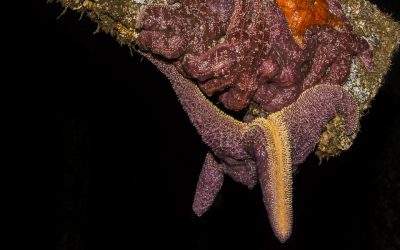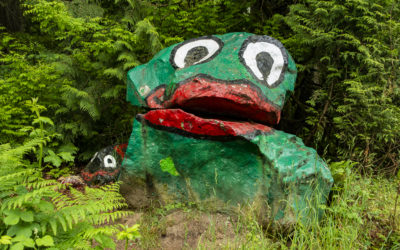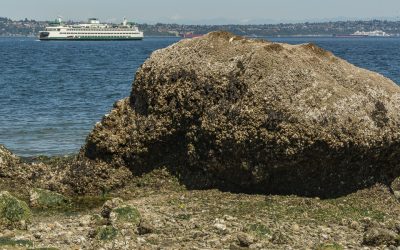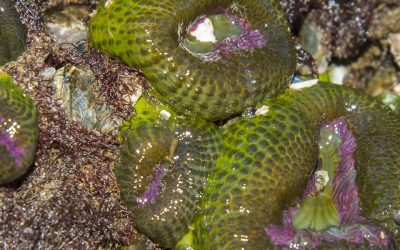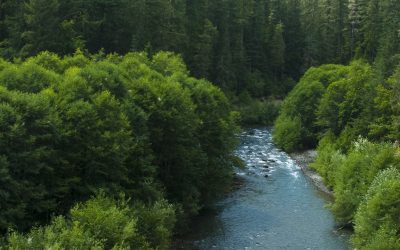Mussel Strength
How Mussels Serve Our Ecosystem
By Jill Needham, Kathleen Alcalá
Photos & video by John F. Williams except where noted
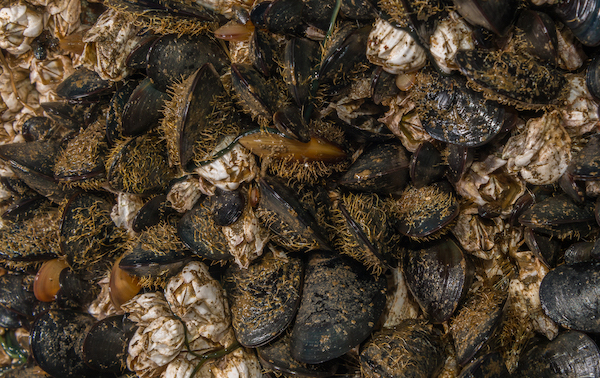
Mussel Strength
How Mussels Serve Our Ecosystem
By Jill Needham, Kathleen Alcalá, Autumn 2018
Photos & video by John F. Williams except where noted
common in the salish sea
Thick mats of blue mussels, also known as bay mussels, cling to hard surfaces of the intertidal zone. Thousands of these bluish-black mollusks can be seen tightly covering the pilings at a dock or on a large boulder during low tide, and their iridescent shells litter beaches and might catch your eyes or cut your bare feet. They can be a tasty source of protein in chowders or steamed on your dinner table. The Blue Mussel, scientifically named Mytilus trossulus, is so common along the protected beaches of the Salish Sea that it would be a challenge to not find any where there are hard surfaces for them to attach. But the Blue Mussel’s sheer abundance does not detract from the vital niche it fills in the ecosystems of the Salish Sea.
Audio version

growing up
The life cycle of the Blue Mussel is more varied than one might expect—they don’t live their whole lives attached to rocks. In fact, the mussel goes through several distinct stages before reaching maturity. Mature male mussels release sperm into the water, which will bond to an egg released by a female. Many things can prompt this release, and given their tightly clustered living situations, the release of sperm or eggs by one will prompt the surrounding mature mussels to spawn as well. The free floating embryo will then develop into a larval form. As larvae, they will float freely in the ocean for about a month while their major body systems form. Eventually, they settle on a suitable rock or other hard surface and attach themselves.
steadfast adherence
To counter the crashing waves day in and day out, these creatures have adapted a novel way of rooting themselves in place. Mussels secrete byssal threads to adhere to various hard surfaces. Also known as the “beard,” because of the resemblance to tough hairs, these fibers are typically removed before cooking. Byssal threads have extremely hardy cores that can heal when damaged, along with a cuticle harder than resin. Juvenile mussels can even use their byssal threads for locomotion by extending, attaching, and pulling themselves forward. In contrast, larger mussels essentially become stationary after they reach two centimeters in length, but they can reattach to substrate should they become dislodged.
Researchers are keenly interested in byssal threads. They can stretch out to 160% of their initial length and still be five times the strength of a human Achilles tendon (Brentner, Laura, 2002). Currently, chemical engineers are using mussel DNA in yeast to generate biodegradable complex polymer structures that can be used for coatings that are both stretchy and hard. A number of studies indicate that mussel glues may have useful surgical applications for wound care. The threads themselves may facilitate the creation of artificial tendons (Qin). This is still not the mussels most important contribution.

eye catching iridescence
Walking on a beach, one of the first things to catch your eye might be the vivid iridescence of a mussel shell, the remnants of a life that lived within before a shorebird or other predator ate it. It can look like a dragon’s scale. Mollusks produce nacre, also known as Mother of Pearl, to line their shells. It is strong, resilient, and iridescent. The layers of nacre smooth the inner surface of the shell, protecting the soft body, and defending mussels against parasites and sediments. The lining also reinforces the more brittle outer shell, strengthening the mussel against the tides that surge and pull against it.
blue mussels & other creatures
Many people think that anemones are merely squishy colorful blobs—and they wouldn’t be wrong. Anemones are fairly stationary but they’re also carnivorous predators. They have been known to prey on small marine life such as crustaceans, oysters, and mussels. Even sea birds have been observed making meals of mussels.
Sea stars also feast on mussels. (See the videos in the article on sea stars.) Predacious interactions between mussels and sea stars are so common that sea stars may completely wipe them out in some stretches of coastline. By keeping populations in check, sea stars prevent mussels from out competing other sea creatures for valuable hard substrate. For this reason, sea stars are seen as a keystone species in the Pacific Northwest.
Barnacles and mussels both occupy similar niches in marine ecosystems. Both are filter feeders bound to hard surfaces of the intertidal zone. To prevent drying out, they have adapted to retain water after the tide has receded.
Suitable hard surfaces in the intertidal zone are limited and mussels will find themselves in competition with barnacles. Yet they also provide services for each other. Barnacles help camouflage mussels from natural predators by disguising their shape and blue color with the surrounding substrate.
Adhering directly to the mussel’s shell is advantageous for the barnacle in many ways. By attaching themselves near the siphon of the mussel, barnacles can benefit from the plankton rich micro currents that are created by the mussel’s siphon. For the mussel, barnacles on its surface makes it more vulnerable to drag and wave action, causing the mussel to spend more energy creating byssal threads to properly adhere itself to substrata. Although the relationship may oscillate between mutualistic and parasitic, they both occupy vital niches in the ecosystem.
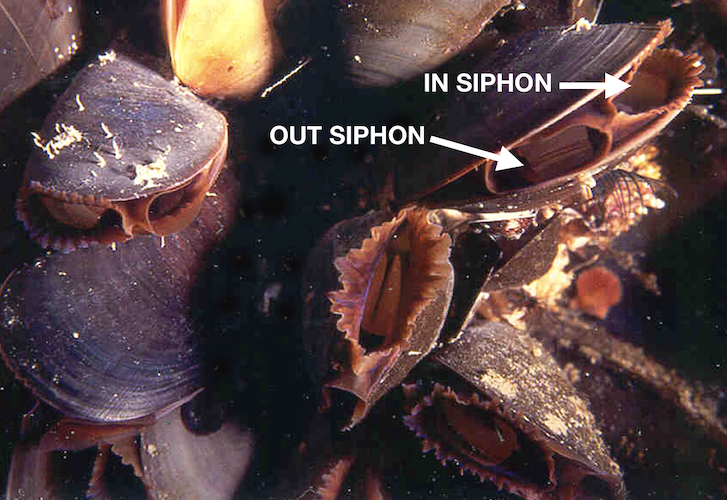
photo by Nancy Sefton
janitors of the oceans
One of the most significant traits of mussels is their adept ability to filter feed. They feed on free floating plankton and other microscopic sea creatures. Mussels have two siphons, one draws in seawater and the other expels the water. In between, the water is pushed through gill-like filters that extract oxygen and food from the water.
Most of us don’t see them in their active state because when the tide recedes they close their shells to prevent water loss. Drying out is one of the many hurdles faced by intertidal life. However, when submerged, mussels relax the ligament holding their shell closed and allow seawater to flow in. You can sometimes see them with their shells open, filter feeding, by peering over the side of floating docks when mussels are attached near the surface.
As the mussels feed, particles such as phytoplankton that thrive in the nutrient-rich waters of the Salish Sea (Snow, et al. 2005), become trapped in the mussel’s filters and are digested. Because phytoplankton are so small, a mussel needs to filter large volumes of water in order to obtain enough food to sustain itself. Each mussel will filter about a bathtub’s worth of water each day (Science Learning Hub).
A side-effect of the mussel’s feeding strategy is that a considerable amount of plankton is removed from the water. This helps balance the input of nutrients to the Salish Sea.
As they feed by filtering the water, mussels also remove toxins, both biological and synthetic, from the water. Some of the toxins are broken down by the mussel, and others accumulate in their tissue.
The Washington State Departments of Ecology and Fish and Wildlife utilize these mollusks in an ongoing study to determine the pollutants in Puget Sound waters. Persistent organic pollutants and heavy metals are adsorbed into the guts of the mussels. Mussels are set on beaches in cages in late fall. The cages and mussels remain at specific sites for three months. Upon retrieval, the mussels are analyzed at the Fish and Wildlife labs. Upon examination, it is possible to determine the type and quantity of these pollutants in the nearby waters.
a place to live
Let’s take a look at one important role of these large boulders on the beach: a place for marine life to attach. Other articles in this issue describe some of the marine creatures like mussels, barnacles and anemones that attach to stable, hard surfaces like boulders. Their strategy is to live in one place and allow the currents to bring them the plankton that they feed on. There is also an article about sea stars that are often found on these hard surfaces preying on the attached life.
One of the interesting things about giant rocks on the beach is that one can see the high tide line by the growth on the hard surface.
As a matter of fact, if the boulder is large enough and low enough in the intertidal zone, one can see horizontal layers of life. The most resilient creatures, those that can tolerate the most time out of the water, will be near the top. The mix of creatures at the bottom will include those that are less tolerant of being dry. The Salish Sea has quite a large tidal swing, so if the boulder is large enough, this “graph” of tide-tolerant creatures can be more than 10 feet tall in some locations.
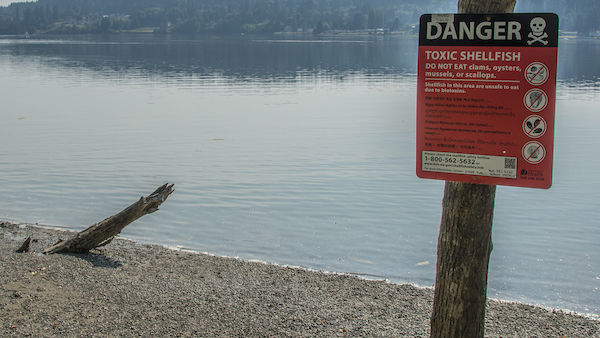
humans & blue mussels
Humans and mussels share a rich history dating back thousands of years. Most species are edible and, of those, Mytilus trossulus is one of the most commonly consumed species. The Inuit even harvest blue mussels from ice caves during low tide (https://www.nytimes.com/2017/03/17/world/canada/mussels-under-ice-canada.html). Mussel meat is naturally low in sodium and fat while being high in protein. During World War II, mussel meat was used as a viable alternative to red meat during wartime rationing.
Here in the Salish Sea, blue mussels can be harvested along many of our shorelines. However, because they filter toxins, you need to make sure the location you have in mind is OK for mussel harvest on the day you plan to go. Dinoflagellates, otherwise known as red tides, contain toxins that can cause serious illness in humans such as paralytic shellfish poisoning (WDFW). All beaches along the east side of Puget Sound from Everett south to Olympia have been closed to shellfish harvest for many years due to human-caused pollution concerns. See “Find Out More” below for more info about safe shellfish harvesting.
Mussels might be considered a nuisance, especially when they adhere to docks and pilings, but the services they provide make them an important part of the intertidal ecosystem. They are food for many predators, including humans. They provide space for barnacles in a mutual relationship of both support and competition for hard surfaces. But the true beauty of blue mussels lies in their amazing ability to filter over fifty gallons of seawater per animal every day, providing a necessary service for the entire ecosystem of the Salish Sea. Mussels enable much of the life that surges, swims, and clings around them. Next time you are tempted to pull a cluster of mussels from a seawall and cast them away, remember the role they play in the bigger picture. These simple animals consisting of a shell, a soft body, and tough threads are able to maintain their place in the extreme environments of the intertidal zone and act as little scrubbers for seawater, thus benefiting all of us.
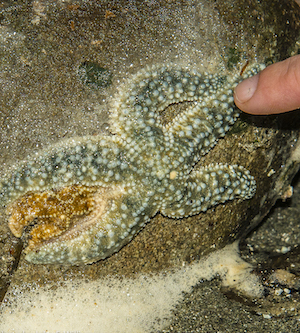
In Spring, 2018, Jill Needham was a student at WWU’s College of the Environment in a class titled “Research of the Salish Sea” taught by Jenise Bauman. Jill and other members of her class researched and authored articles for this inaugural issue of Salish Magazine.

Kathleen Alcalá is the author of a short story collection, three novels set in 19th Century Mexico and the Southwest, and a collection of essays based on family history.
Kathleen’s latest book is “The Deepest Roots: Finding Food and Community on a Pacific Northwest Island.” Kathleen has an M.A. in Creative Writing from the University of Washington and a Master of Fine Arts from the University of New Orleans. She was a faculty member at the Northwest Institute of Literary Arts on Whidbey Island. She still lectures and gives readings and workshops in creative writing.
Table of Contents, Issue #1, Autumn 2018
Seeing Stars?
By Jeanne Wright, Nancy Sefton Photos & video by John F. Williams except where notedA Struggling Keystone Species By Jeanne Wright, Nancy Sefton, Autumn 2018 Photos & video by John F. Williams except where notedcommon in the salish sea Several kinds of...
Big Boulders
By Greg Geehan, John F. Williams Photos & video by John F. Williams except where notedA Place to Attach By Greg Geehan, John F. Williams, Autumn 2018 Photos & video by John F. Williams except where notedMuch of the sand and gravel on Salish Sea beaches comes...
The Barnacle
By Tasha Smith, Leigh Calvez, Deb Rudnick Photos & video by John F. Williams except where notedMore Than Meets the Eye By Tasha Smith, Leigh Calvez, Deb Rudnick, Autumn 2018 Photos & video by John F. Williams except where notedMy first experience with...
Flower of the Tide Pool
By Briana Sandoval Sharon Pegany Photos & video by John F. Williams except where notedPlant or Animal? By Paul Pegany, Summer 2019 Photos & video by John F. Williams except where noted Aggregating anemones are commonly found at low tide around the Salish...
Postscript-1
By John F. Williams Photos & video by John F. Williams except where notedVisualizing an Ecosystem By John F. Williams Photos & video by John F. Williams except where notedTelling the story of a system as complex as the ecosystem we live in is a tall order....
FIND OUT MORE
Mussel harvesters must be mindful of where and when they harvest shellfish! Maps showing areas that are safe for shellfish harvest are provided by the Washington Department of Health and Fisheries and Oceans Canada:
- https://fortress.wa.gov/doh/eh/maps/biotoxin/biotoxin.html
- http://maps.bccdc.org/shellfish/
- http://www.pac.dfo-mpo.gc.ca/fm-gp/contamination/index-eng.html
There is also a link to a video about recreational shellfish harvest in the “Find Out More” section at the end of this article.

